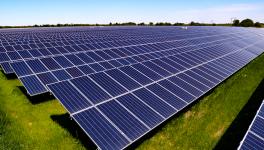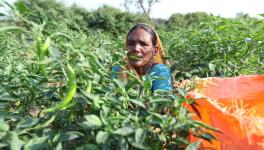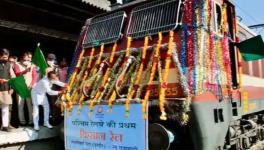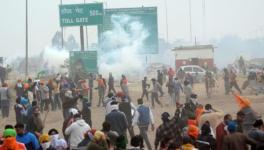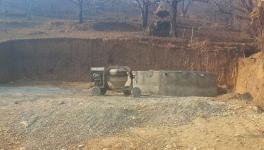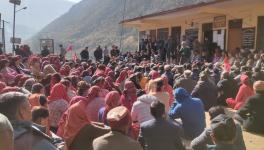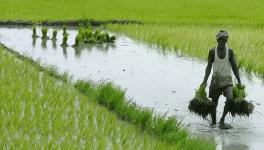Drinking Water Crisis in Karnataka Persists, Forces Schools in Udupi to Stall Mid-Day Meal Scheme
Image for representational use only.Image Courtesy : The Hindu
It is the fourth successive drought year in the state of Karnataka. The state has been facing an acute shortage of drinking water ever since the beginning of this summer. Prajavani, a Kannada daily, reported that the schools in the Udupi district are functioning only in the first half of the day as there is no drinking water in these schools because of the lack of drinking water, more than 100 schools are not able to provide the students with mid-day meals in the Karkala taluk. This situation in the schools was brought to the notice of the Deputy Director of Public Instruction (DDPI). As a temporary solution the schools are functioning only during the first half and students are being sent back home for lunch.
Shashidharan, the Block Education Officer (BEO), speaking to Prajavani, however noted that it is not only drinking water, but in general there is shortage of water in schools and teachers are being forced to borrow water from panchayat offices and houses in the neighbourhood. The BEO also noted that, “the aim is to ensure that the schools are not forced to shut down.”
On May 16, 2019 News 18 had reported that the water level in Baje dam across the Swarna river, which is the main source of water for Udupi, “has reached the dead-storage limit.” According to a report in the New Indian Express, “the water storage at Baje dam may last for just five more days as it is evaporating fast. Udupi City Municipal Council (CMC) is contemplating to bring down the water supply quantity to 3 MLD (Millions of Liters Per Day) from the present 5 MLD.” Reportedly, the CMC is also planning to decrease the hours of pumping of water from 8 hours to 5 hours, to ensure that water is supplied till it rains.
Also Read:Drought in Karnataka: A Human-made Disaster
Severe Water Crisis in the State
The above discussed case of Udupi gives us a glimpse of the drinking water crisis in the state. According to the State Emergency Operation Centre, a total of 996 villages in 26 districts are being supplied drinking water through tankers as a relief measure.
According to the Karnataka State Natural Disaster Monitoring Centre (KSNDMC), there is a shortage of water in all the 13 major dams in the state and is touted as the main reason for the current crisis. There also is depletion of underground water level and as mentioned in the beginning, the state is drought hit for four years now.
The Centre had issued a drought advisory to Karnataka along with Maharashtra, Gujarat, Karnataka, Andhra Pradesh, Telangana and Tamil Nadu in mid-May recommending that water be used for drinking only, and judiciously. The drought advisory is issued to states when the water level in reservoirs is 20 percent less than the average of live water storage figures of the past 10 years.
Karnataka had earlier requested Maharashtra to release water from its Koyna or Warna reservoirs to meet the drinking water needs of Belagavi, Vijayapura and Bagalkot districts. The authorities have now released the water from Almatti dam, to meet water requirements in Kalaburagi, Raichur and Yadgir districts.
Also Read: Centre Reduces Funds for NRDWP in Drought-hit Karnataka, Has No Money for MGNREGS
The state government has so far declared 3,122 regions to be highly affected by drinking water scarcity and this number is only increasing, as reported by News18. According to the Department of Rural Development and Panchayat Raj, off the 176 taluks, 138 have groundwater at a low level. The worst of these are Bagepalli, Chikkaballapura, Sidlaghatta, Bangarpet and Kolar
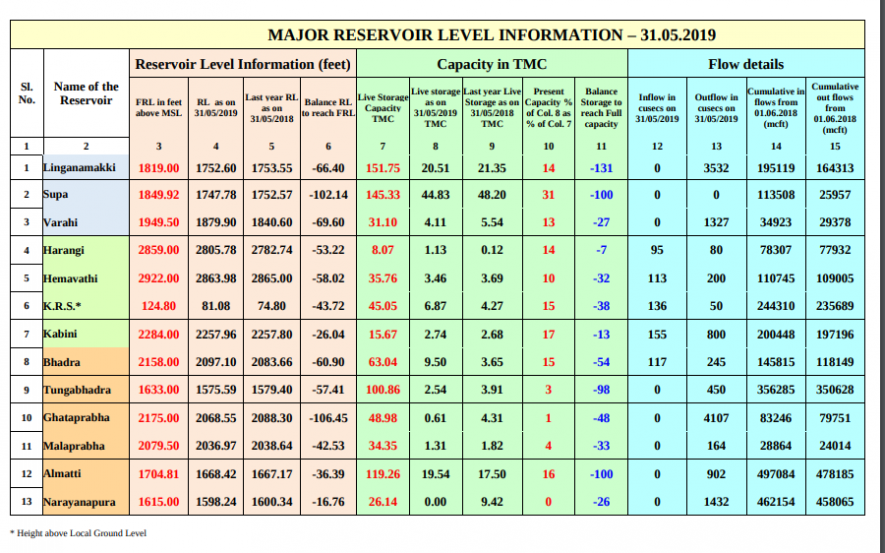
Courtesy: Karnataka State Natural Disaster Monitoring Centre (KSNDMC).
The table above shows tha current water level, the water currently in the reservoir (live storage) and the flow details of all the 13 major reservoirs in the state, compared to the units last year while previous year was also a drought year.
As it can be seen here, apart from Krishna Raja Sagara (KRS) (15%), Supa (31%), Kabini (17%), Linganamakki (14%), Bhadra (15%), Varahi (13%) and Almatti (16%), all the others have way less water as of today compared to the same date (31/05/2018) last year, which however, was also less than live storage capacity of these reservoirs.
On the one hand there are reservoirs like Hemavathi, Tungabhadra, Malaprabha, Narayanapura and Ghataprabha which have the least live storage capacity as of today. Hemavati has 10%, Tungabhadra has 3%, Malaprabha has 4%, Narayanapura has 0% and Ghataprabha has 1 % of the live storage capacity. While Hemavati Reservoir is in Hassan district, all the other reservoirs are the ones on which the northern districts of the state depend. The northern part of the state received deficient rainfall last year and the region is now dependent on the water that is released by the state of Maharashtra.
As the table also shows, all the reservoirs are in the need of substantial amount of water to reach the ‘full reservoir’ level. With the prediction of delay and scanty monsoons, the situation remains worrisomel.
Also Read: The Manual for Drought Management, 2016 Won’t Let North Karnataka Be Declared Drought-hit
Get the latest reports & analysis with people's perspective on Protests, movements & deep analytical videos, discussions of the current affairs in your Telegram app. Subscribe to NewsClick's Telegram channel & get Real-Time updates on stories, as they get published on our website.










